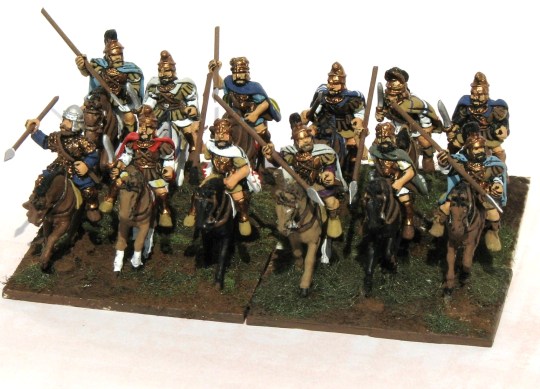 Stało się. Jak to się mówi "otworzyłem puszkę z Pandorą" :) . Rozpoczęcie pracy nad armią Asyrii musiało spowodować pracę nad jej przeciwnikami.
Stało się. Jak to się mówi "otworzyłem puszkę z Pandorą" :) . Rozpoczęcie pracy nad armią Asyrii musiało spowodować pracę nad jej przeciwnikami.Wybór padł na Egipcjan, z okresu po upadku nowego królestwa. W tym właśnie czasie, czyli IX-VII wieku p.n.e. Egipt prowadził wojny z Asyrią o kontrole nad Bliskim Wschodem, stopniowo ja tracąc.
It has happened. As it is said "I,ve opened a box with Pandora" :)Start of the Assyrian army had to cause also work on its enemies.
I chose Egypt from the period after the fall of the New Kingdom. In this period (9th to 7th century B.C.) Egypt was fighting Assyria over control of the Middle East and was gradually loosing it.
Pierwszym elementem nowej armii który pomalowałem jest dowództwo piechoty. Pierwszym zwracającym uwagę szczegółem jest kolor skóry wojowników. Okres po upadku Nowego Królestwa to czas rządów tak zwanej Dynastii Nubijskiej. Oznacza to, że elita państwa była raczej ciemnoskóra. Nubijczycy pochodzili z terenów obecnego północnego Sudanu. Już wcześniej mieli szerokie kontakty z Egiptem. Przyjeli również w dużej mierze egipską kulturę i zwyczaje, w tym stroje.
Infantry command ist the
 first painted element of the army
first painted element of the armyFirst distinctive feature of these warriors is their skin colour. Period after fall of the New Kingdom is a period of Nubian Dynasty. It means that new elite of Egypt had rather darker skin. Nubians came from territory of what is now northern Sudan. Even earlier they had wide contacts with Egypt. They accepted Egyptian culture and customs. They also wore Egyptian clothes.
Oznacza to, że armia z tego okresu będzie podobna do armii Nowego Królestwa, z tą różnicą, że w związku z upadkiem znaczenia i finansów państwa nie będzie uzywała tak wielu rydwanów jak wcześniejsze.
Zdecydowałem, że kolor skóry żołnierzy bedzie różnorodny.
It means that this army will be similar to earlier of the New Kingdom. The main difference is it will have less chariots. Egypt in this period was facing financial problems so probably couldn't affor to keep as many chariots as earlier.
I've decided that warriors of this army will have various skin colours.
Sztandarowy trzyma sztandar z głową kozła. Kozioł w mitologii egipskiej symbolizował Amona, jednego z głównych bogów. Egipcjanie mieli zwyczaj nazywania jednostek wojskowych własnie od imion bogów.
Oficer jest nieopancerzony i uzbrojony w topór z brązu. Oznacza to, że jest raczej dowódcą niższego szczebla, choć w armii egipskiej pancerze były niezwykle rzadkie, więc prawdopodobnie mogli sobie na nie pozwolić tylko gwardziści faraona i ludzie z jego bezposredniego otoczenia.
Poza sztandarowym i oficerem na podstawce jest również "oficer łącznosciowy" czyli bebniarz. Bębny były jednym z dostepnych wówczas środków przekazywania rozkazów oddziałom.
Standard bearer has a standard with Ram's head. Ram in Egyptian mythology was associated with Amun, one of the most important gods. Egyptians had a habit of calling army units from names of their gods.
Officer is unarmoured and armed with a bronze axe. It means he is of rather lower status. In egyptian army armour was rare and probably only Pharoh's guards and people from his entourage could afford one.
Apart from standard bearer and an officer on a stand there is a "communication officer" - a drummer. Drums were one of the means to communicate commands to the troops.





















Brak komentarzy:
Prześlij komentarz